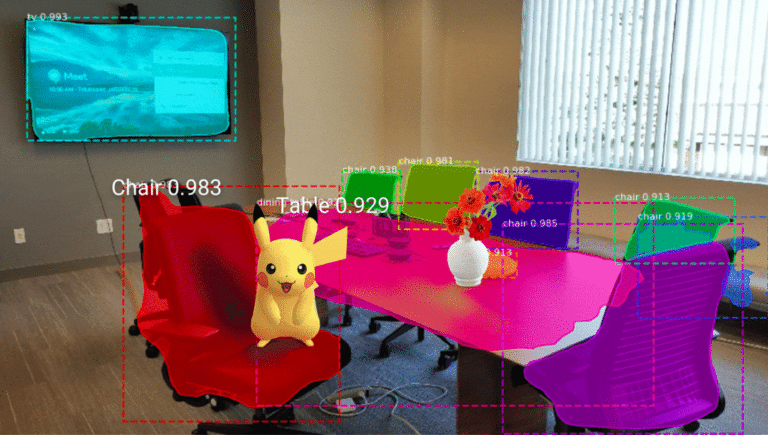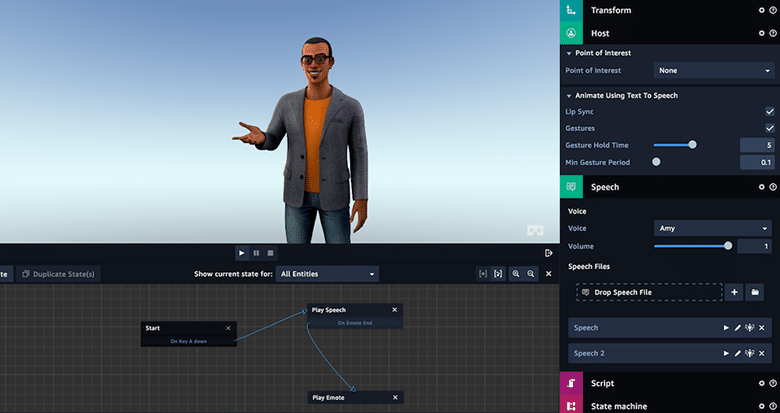
Our 2019 predictions projected “building blocks” as a breakout AR category. We’re at the point in spatial computing’s lifespan when the proverbial gold-rush picks & shovels are needed to enable developers and to accelerate growth.
This can be a broad designation, including the technologies we’ve examined like the AR Cloud and even 5G + edge connectivity. Another emerging sub-sector that constitutes “building blocks” is tools that democratize the creation of 3D graphical assets for spatial experiences.
These are literally the building blocks of spatial UX. Game engines like Unity have already democratized 3D creations with tools and graphical elements for 3D worlds. Google Blocks lowered the barrier further for creating assets with limited programming skills.
Google also launched Poly, which is an online library of graphical assets that can be used by AR and VR creators. Sketchfab is another such tool, as marketplace for creators to display and sell 3D graphical assets. And it recently passed one billion cumulative page views.

Creative Muscle
Other important creation tools include Amazon Sumerian. This is a platform, run under Amazon’s AWS, which lets developers and brands create and run VR and AR apps, or 3D graphics. It boasts drag & drop functionality and not requiring specialized programming nor 3D graphics expertise.
One example is an early prototype built on Sumerian by Fidelity Labs, a division of Fidelity Investments. It’s a 3D virtual persona that provides voice-guided visualization for investment data. In fact, virtual hosts are one of Sumerian’s early and demonstrative use cases.
“Hosts are probably the biggest building block of Sumerian that’s obvious right now,” Sumerian GM Kyle Roche told us. “Having a character you can make eye contact with, set up in the same way you’d set up an Alexa skill, just drag and drop in a browser, is super attractive for some.”
This will be especially useful in functions like customer service and brand marketing. In these cases, XR creation can be enabled or accelerated if it can be built in-house. Or even in the case of outside help from creative agencies, they need tools like Sumerian to build XR apps for clients.

“A lot of enterprises or smaller shops want to get into XR,” said Roche. “As they see it come to life, they’re thinking ‘Okay, I need to get a 3D game engine, learn how to sculpt, animate, rig and all these complex things.’ They just want something that’s easy to use in a familiar environment.”
There’s also Adobe Aero, a tool to similarly provide a drag & drop creation environment for spatial computing. One of its biggest advantages is that it plugs right into Adobe Creative Suite, which is a ubiquitous platform for creative professionals, including tools like Photoshop and Premier.
“Adobe has always embraced new mediums from print and PC to web and mobile,” said CTO Abhay Parasnis at the Adobe MAX conference. “We’ve always looked around the corner to figure out the next creative medium. We truly believe that we’re at a similar inflection point with AR.”
Aero integrates with Photoshop and other Creative Cloud programs to output 3D graphics that are AR-ready. It’s also working with Apple and others to standardize the USDZ file format for AR project workflows. This makes exported 3D graphics compatible with Apple’s “Quick Look.”

Business Case
Speaking of Quick Look, one key use for 3D graphics is product visualization. This popular AR function requires 3D scans that have dimensional accuracy to simulating in-home spatial product placement. But it requires AR-ready scans for vast libraries of products.
“Whenever anyone asks what they need to do to get ready for the future, I say make digital twins of everything in your inventory,” Unity’s Timoni West told us. “A lot of companies don’t have that right now or they have CAD files for 3D printing that are way too big and won’t work for mobile.”
In the near term, IKEA, Wayfair and others offering AR visualization rely on individual solutions to scan products. But the real opportunity is for specialized and standardized methods that can help them scale up 3D image libraries, and bring it within reach of smaller down-market players.
E-commerce platform Shopify has done similar by bringing AR product visualization to 600,000 businesses. Using the aforementioned USDZ file format, Shopify merchants can create 3D graphics that are immediately usable in Apple’s Quick Look AR feature.
“Wayfair and IKEA have their own means and methods they’ve created in-house, because there’s nothing out there that’s scalable, affordable and easy,” said Super Ventures Partner Tom Emrich at a recent event. “These are startup opportunities that, as an investor, I’m looking at.”

AR as a Service
Sticking with the theme of building blocks and enabling-technologies, a key concept that emerged in 2018 was AR as a Service (ARaaS). Like software as a service began to do a decade ago, ARaaS democratizes advanced AR functionality and architecture to lower the barriers for AR.
The company that introduced this concept to us in 2018 was Niantic. The Pokemon Go and Ingress creator recently turned its AR architecture into a platform on which others can build apps. Known as Real World Platform, it productizes the underlying code base for Niantic’s AR games.
Similar to Amazon Web Services’ (AWS) inception, Niantic built its engine primarily to drive its own product. But then it realized that it can be its own platform. And like AWS, it could be a highly scalable revenue stream, making it opportunistic for Niantic and transformative to the industry.
“AWS and GCP weren’t built as compute platforms for everybody,” said Niantic CTO Phil Kelsin at AWE in May. “They were built to support the applications of Amazon and Google. Then they decided ‘we have excess capacity let’s turn it into something that our users can use.'”

Proof Points
Of course, this is all conceptual: The real value of Niantic’s Platform will lie in its execution and functionality. And there, the question is capability. In other words, Pokemon Go is a primitive form of AR, so will it spawn a valuable platform? That’s where Niantic’s acquisition spree comes in.
Real World Platform is strategically timed to incorporate IP that Niantic has been scooping up and adding to its already-scalable infrastructure. That includes Escher Reality (multi-player & social AR) and Matrix Mill (occlusion and computer vision), which contribute to its “Planet Scale AR.”
The idea is to have more robust computer vision and machine learning to contextualize real-world items. Then, scene mapping from Matrix Mill can infuse graphics in dimensionally accurate ways, and Escher’s social AR capabilities enable collaboration. Niantic will keep building this stack.
But before developers get the chance to build AR apps and games using the Real World Platform, we’ll get to see its first proof of concept: Harry Potter, Wizards Unite. Niantic’s follow-up to Pokémon Go will be an important test for the platform, and for AR’s mass appeal in 2019.
“One of the things we had to do along the way was respond to player behavior and things that happened in the game,” said Keslin. “Network problems, system problems, and fixing those in real time. We’re going to take all of that and we’re going to pour it into Harry Potter, Wizard Unite.”
For deeper XR data and intelligence, join ARtillery PRO and subscribe to the free AR Insider Weekly newsletter.
Disclosure: AR Insider has no financial stake in the companies mentioned in this post, nor received payment for its production. Disclosure and ethics policy can be seen here.
Header image credit: Niantic
